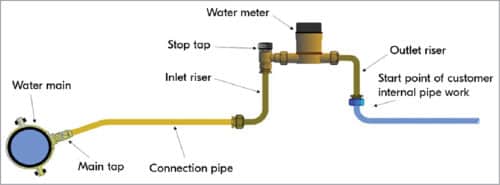Consumption of different forms of energy including electricity, gas, and water by residential, commercial and industrial establishments is measured using meters. As water becomes scarce in many areas, smart water meters are finding widespread use worldwide due to such features as accurate and precise reading, communication control, automatic fault detection and more. With the rise of the Internet of Things (IoT) in the past decade, sensors and mobile apps are getting more commonly employed to automate remote monitoring of consumption levels and billing in real time. Ultrasonic and magnetic flow meters are the most common choices for measuring water usage.
In a smart meter, a microcontroller (MCU) interfaces to the sensor, display and communications block, which is usually a wireless transmitter or transceiver. New-generation smart water meters use long-range wireless-protocols like WM-BUS and Lora or Sigfox to transmit the encrypted consumption information to a wider area. Communication modules integrated with the meters must support all major protocols, both long-range and short-range. For accurate analysis and billing, timing synchronisation becomes crucial in wireless networks.
Consumers can adjust their behaviour accordingly and collected data can even be used to predict consumption patterns. The global smart water metering market is expected to grow at a CAGR of 13.3 per cent between 2019 and 2025, with a CAGR of 20.8 per cent in Asia-Pacific region, according to a recent report from Trends Market Research.
Just like any other intelligent embedded system, choosing the right MCU is essential to provide long operational life and meet the computing needs for smart meters. Different parameters including cost, hardware interface and architecture, software architecture, processing power, memory, power efficiency, and so on are the key factors when it comes to selecting an MCU.

MANAS, a Turkey-based smart meter development company, planned to develop a new smart water meter that could meet the latest standards. The chosen MCU product was available at a low cost and was suitable for basic operations. However, there were certain limitations on the platform as well as RAM scalability that made it an inapt choice for highly efficient smart meters.
Water meters need to be battery powered as they are usually located underground, or in other areas where electricity is inaccessible due to safety concerns. They also need to be energy-efficient so that they last for a reasonable period of time. Software and documentation tools enable designers to easily integrate the necessary functionalities into the smart meters, thereby resulting in better performance and faster time to market.
The company’s search for an alternative finally ended with EFM32 Gecko MCU by Silicon Labs. The cost-effective MCU family is based on ARM Cortex-M3 CPU platform along with scalable flash memory configurations up to 128kB, 16kB of RAM and CPU speeds up to 32MHz. It also features low standby current consumption, short process time, fast wake-up time from energy-saving modes and several peripheral choices. These features can adequately cater to battery-operated applications, according to silabs.com.
The result was successful production of an eco-friendly and energy-efficient smart water meter with a lifespan of fifteen years and required capabilities at a low-cost.
Many other companies like Toshiba, STMicroelectronics, and Texas Instruments (TI) also offer MCUs for smart metering solutions. MSP430FR4xx is one such MSP430 ferroelectric RAM (FRAM)-based 16-bit microcontroller series from TI. It includes a wide range of analogue and digital peripherals that makes configuration simple and reduces PCB size. FRAM combines the abilities of both RAM and ROM to ensure high speed, high endurance, ultra-low power consumption, stability, flexibility, and more.
Reference designs provided by the company make it easier to retrofit the pre-existing water meters with automated meter reading (AMR) capabilities. With its ultrasonic sensing feature, even small water leaks can be detected so that they get repaired rapidly. This not only benefits the dealer and consumer through intelligence and connectivity but also the environment by conserving water and energy.





